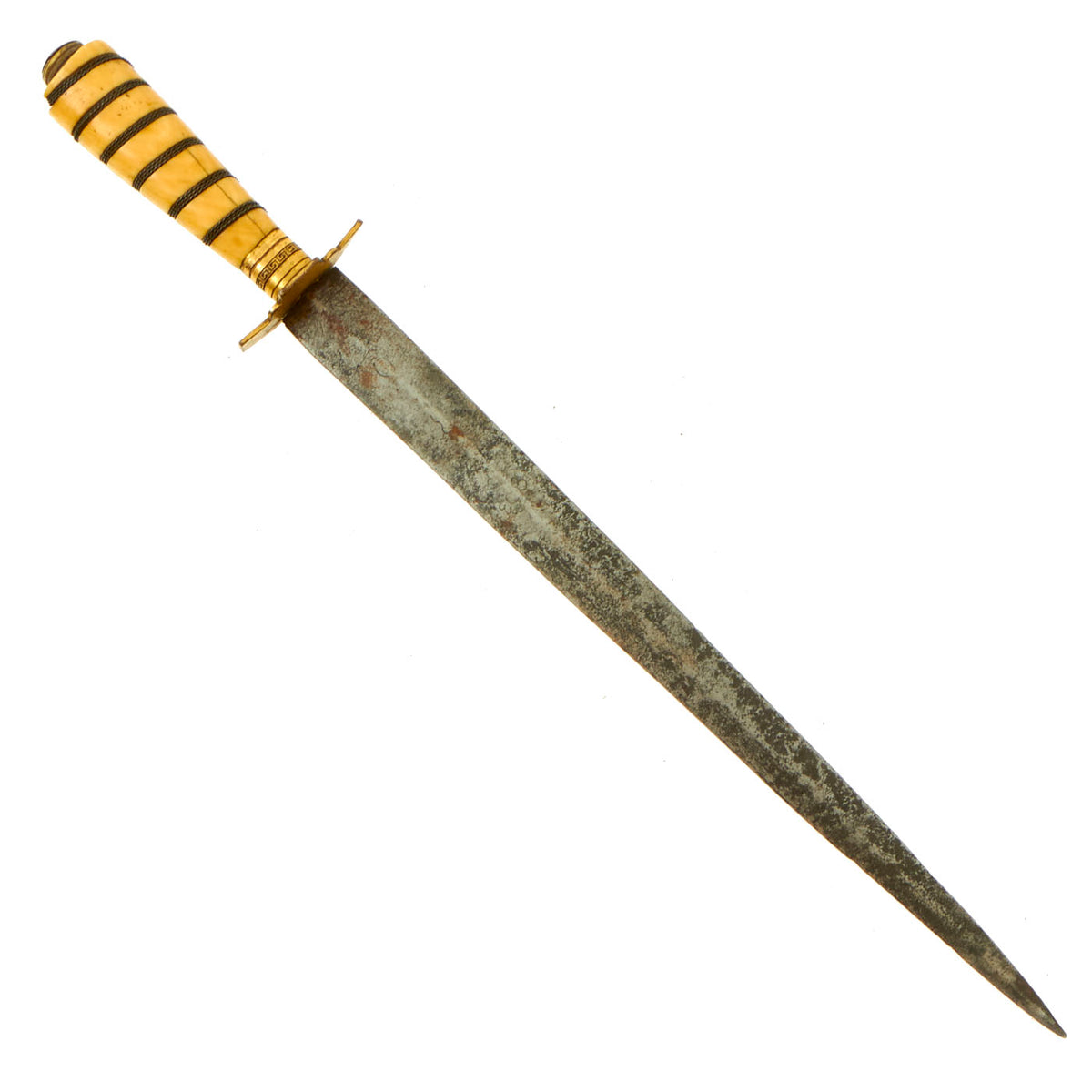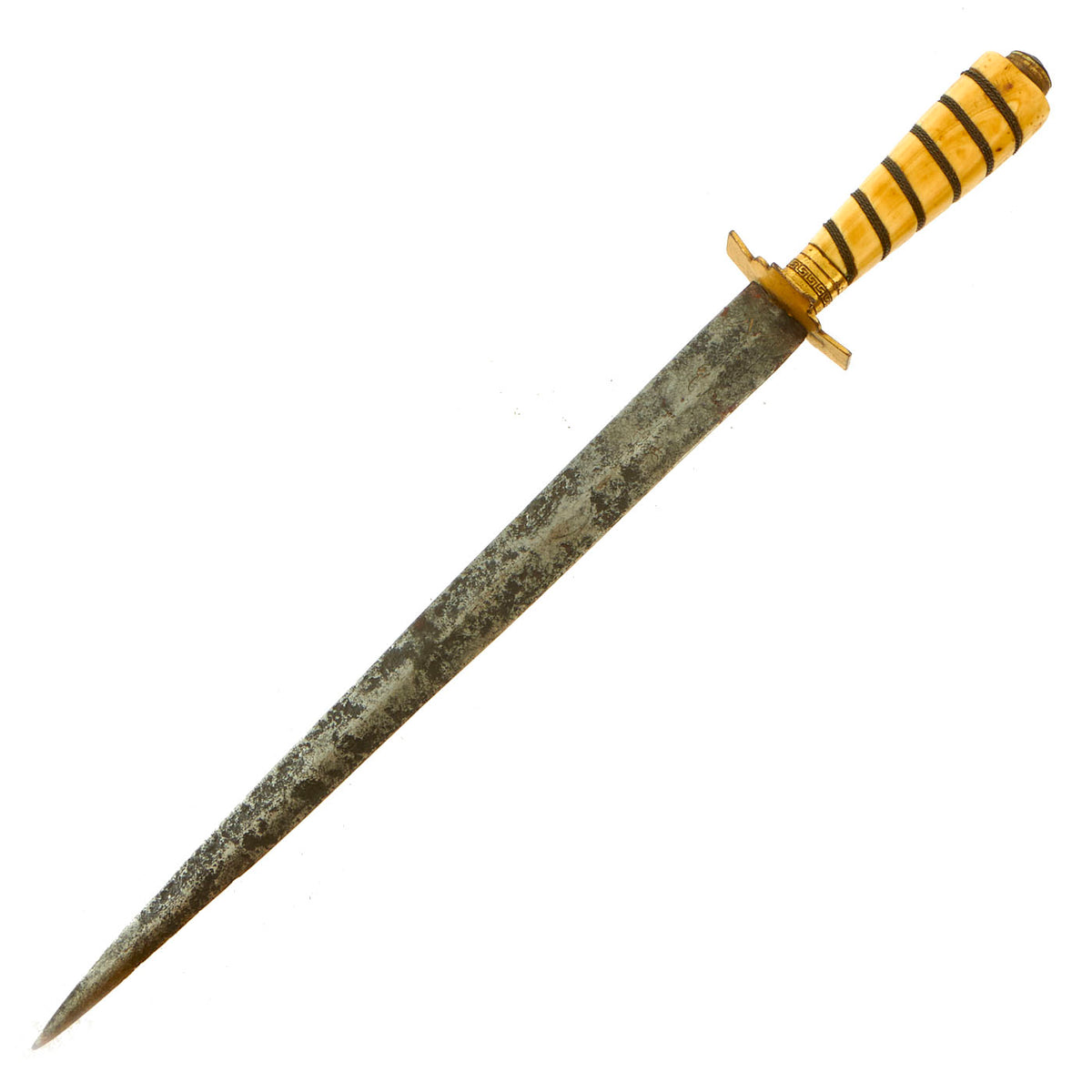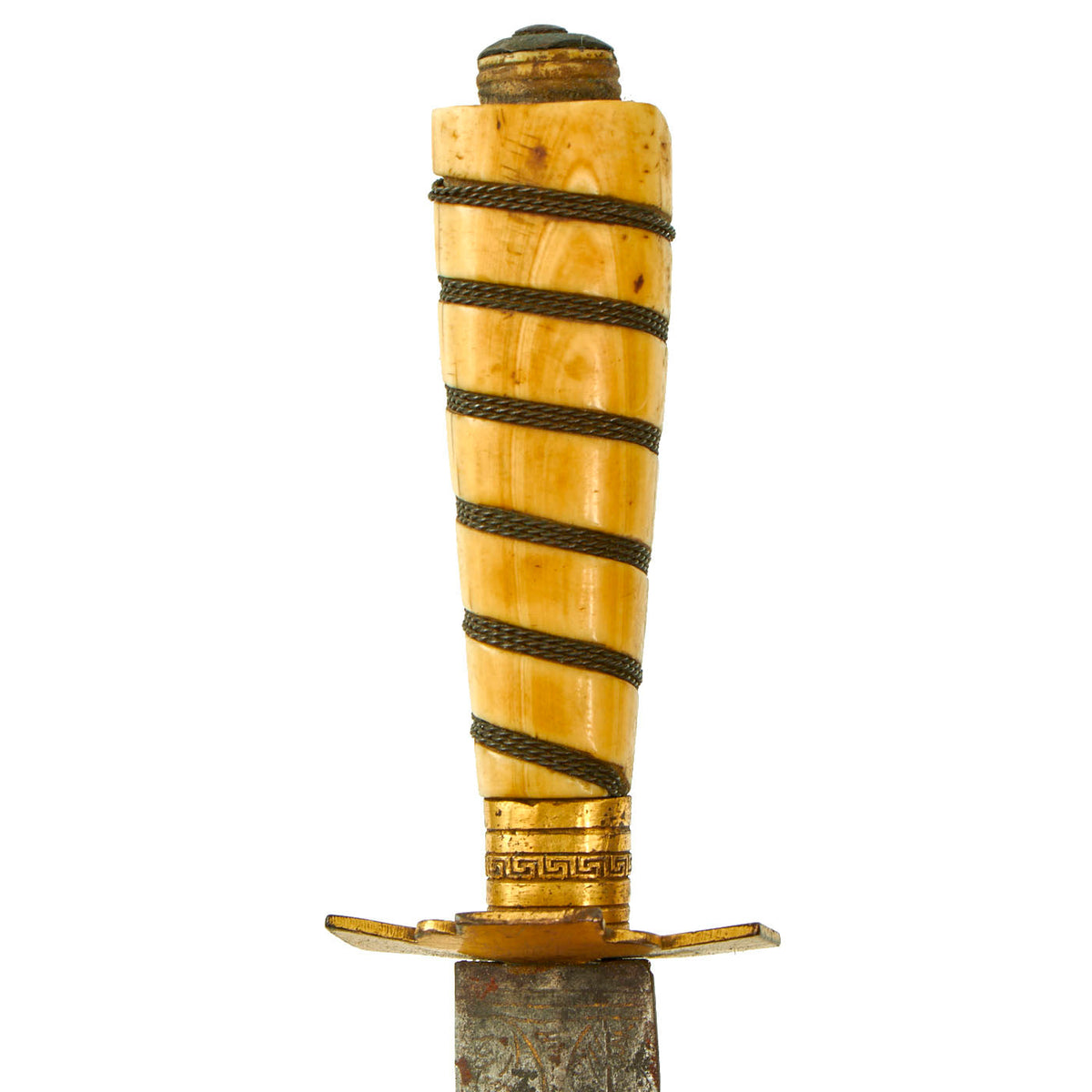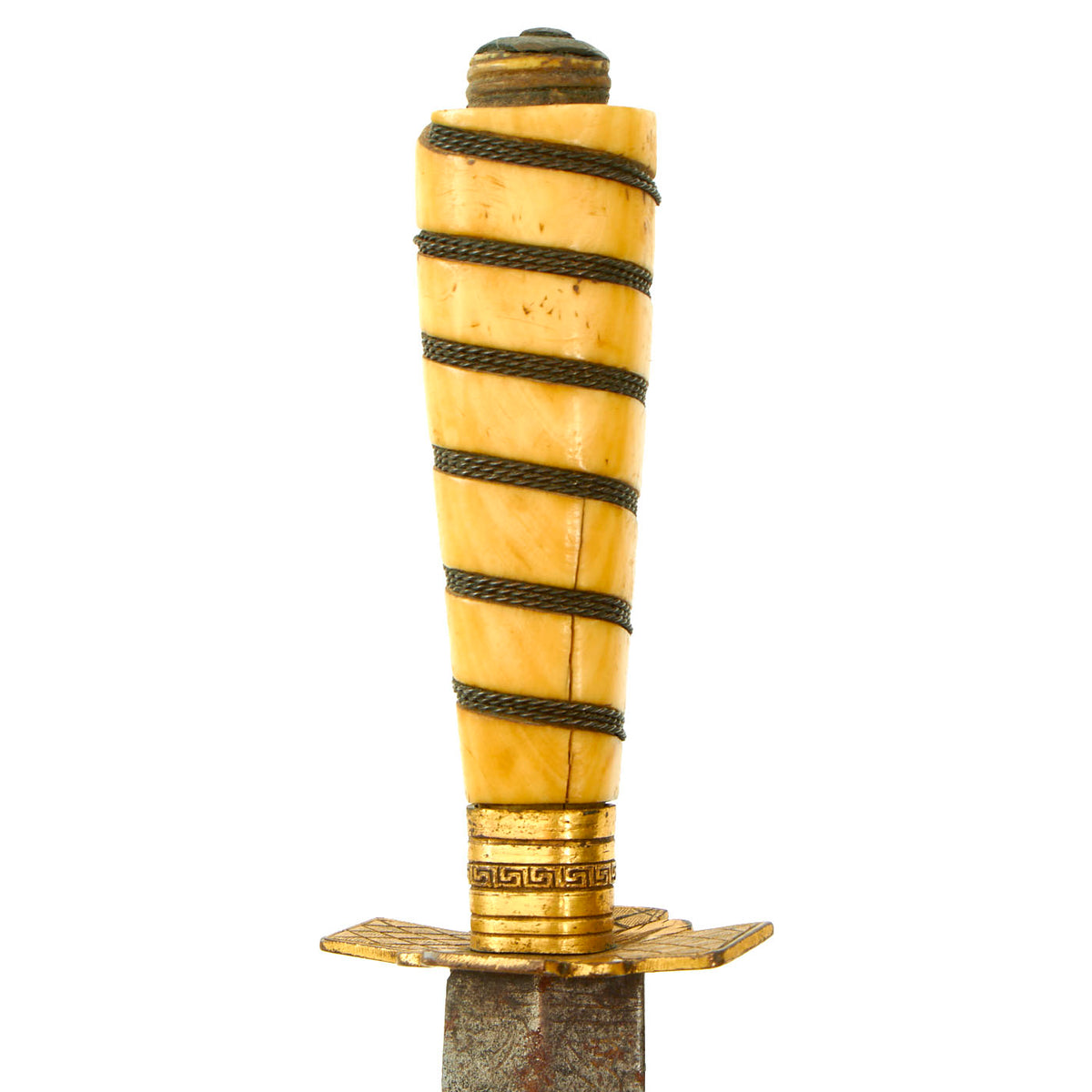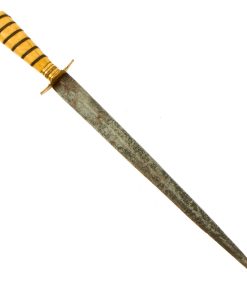Original British War of 1812 Era Royal Naval Officer’s Dirk Original Items
$ 595,00 $ 178,50
Original Item: Only One Available. Now this is a lovely piece of early 19th Century Naval History. This long bladed thrusting dagger, known as a Dirk, dates back to the War of 1812 era. Historically, the Dirk gained its name from the Highland Dirk where it was a personal weapon of officers engaged in naval hand-to-hand combat during the Age of Sail as well as the personal sidearm of Highlanders. It was also the traditional sidearm of the Highland Clansman and later used by the officers, pipers, and drummers of Scottish Highland regiments around 1725 to 1800 and by Japanese naval officers.
A thrusting weapon, the naval dirk originally functioned as a boarding weapon and as a functional fighting dagger. During the days of sail, midshipmen and officers wore dirks; the daggers gradually evolved into ceremonial weapons and badges of office. In the Royal Navy, the naval dirk is still presented to junior officers; the basic design of the weapon has changed little in the last 500 years.
This Dirk is in wonderful condition, but does have old pitting scattered throughout the 8 ¼” blade. The blade is etched on both sides with what looks to be floral patterns. The etching is hard to make out due to the pitting and oxidation present. The 2 ⅞” handle appears to be made of wire wrapped bone or antler and is in lovely condition but does have a slight crack towards the crossguard. The copper crossguard measures approximately 1 ⅜” x 1” and looks to be made of a single piece of brass. The designs in the crossguard are still visible and is a checked pattern with petals in the corners. The fittings are loose, which is expected from material degradation and shrinkage.
This lovely piece of Naval history comes more than ready for further research and display.
Dimensions:
Blade length: 8 ¼”
Blade Style: Spear Point Knife
Overall length: 10 1/8”
Crossguard: 1 ⅜” x 1”
War of 1812
The War of 1812 was fought by the United States of America and its indigenous allies against the United Kingdom and its allies in British North America, with limited participation by Spain in Florida. It began when the United States declared war on 18 June 1812 and, although peace terms were agreed upon in the December 1814 Treaty of Ghent, did not officially end until the peace treaty was ratified by Congress on 17 February 1815.
Tensions originated in long-standing differences over territorial expansion in North America and British support for Native American tribes who opposed US colonial settlement in the Northwest Territory. These escalated in 1807 after the Royal Navy began enforcing tighter restrictions on American trade with France and press-ganged men they claimed as British subjects, even those with American citizenship certificates. Opinion in the US was split on how to respond, and although majorities in both the House and Senate voted for war, they divided along strict party lines, with the Democratic-Republican Party in favor and the Federalist Party against. News of British concessions made in an attempt to avoid war did not reach the US until late July, by which time the conflict was already underway.
At sea, the far larger Royal Navy imposed an effective blockade on U.S. maritime trade, while between 1812 to 1814 British regulars and colonial militia defeated a series of American attacks on Upper Canada. This was balanced by the US winning control of the Northwest Territory with victories at Lake Erie and the Thames in 1813. The abdication of Napoleon in early 1814 allowed the British to send additional troops to North America and the Royal Navy to reinforce their blockade, crippling the American economy. In August 1814, negotiations began in Ghent, with both sides wanting peace; the British economy had been severely impacted by the trade embargo, while the Federalists convened the Hartford Convention in December to formalize their opposition to the war.
In August 1814, British troops burned Washington, before American victories at Baltimore and Plattsburgh in September ended fighting in the north. Fighting continued in the Southeastern United States, where in late 1813 a civil war had broken out between a Creek faction supported by Spanish and British traders and those backed by the US. Supported by US militia under General Andrew Jackson, the American backed Creeks won a series of victories, culminating in the capture of Pensacola in November 1814. In early 1815, Jackson defeated a British attack on New Orleans, catapulting him to national celebrity and later victory in the 1828 United States presidential election. News of this success arrived in Washington at the same time as that of the signing of the Treaty of Ghent, which essentially restored the position to that prevailing before the war. While Britain insisted this included lands belonging to their Native American allies prior to 1811, Congress did not recognize them as independent nations and neither side sought to enforce this requirement.
Fast Shipping with Professional Packaging
Thanks to our longstanding association with UPS FedEx DHL, and other major international carriers, we are able to provide a range of shipping options. Our warehouse staff is expertly trained and will wrap your products according to our exact and precise specifications. Prior to shipping, your goods will be thoroughly examined and securely secured. We ship to thousands clients each day across multiple countries. This shows how we're dedicated to be the largest retailer on the internet. Warehouses and distribution centres can be located throughout Europe as well as the USA.
Note: Orders with more than one item will be assigned a processing date depending on the item.
Before shipping before shipping, we'll conduct a thorough inspection of the items you have ordered. Today, the majority of orders will be delivered within 48 hours. The delivery time will be between 3-7 days.
Returns
The stock is dynamic and we cannot completely manage it because multiple stakeholders are involved, including our factory and warehouse. So the actual stock may alter at any time. It's possible that you may not receive your order once the order has been made.
Our policy is valid for a period of 30 days. If you don't receive the product within 30 days, we are not able to issue a refund or an exchange.
You can only return an item if it is unused and in the same state as the day you received it. You must have the item in its original packaging.
Related products
Uncategorized
Uncategorized
Uncategorized
Uncategorized
Uncategorized
Uncategorized
Uncategorized
Uncategorized
Uncategorized
Uncategorized
Armoured Fighting Vehicles of the World: AFVs of World War One (Hardcover Book) New Made Items
Uncategorized
Uncategorized
Band of Brothers ORIGINAL GERMAN WWII Le. F.H. 18 10.5cm ARTILLERY PIECE Original Items
Uncategorized
Armored Burgonet Helmet & Polearm from Scottish Castle Leith Hall Circa 1700 Original Items
Uncategorized
Australian WWII Owen MK1 Machine Carbine SMG Custom Fabricated Replica with Sling Original Items
Uncategorized
Uncategorized
Uncategorized
